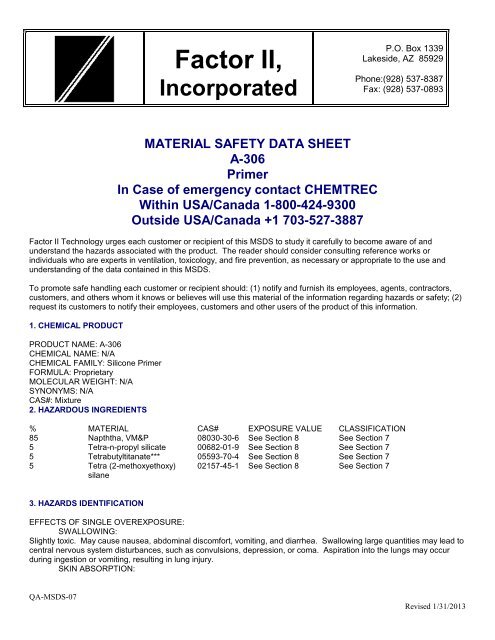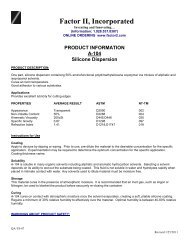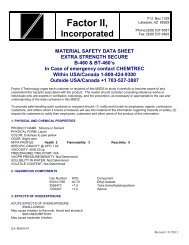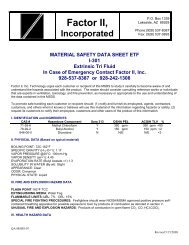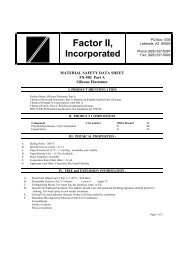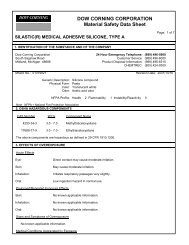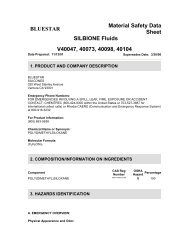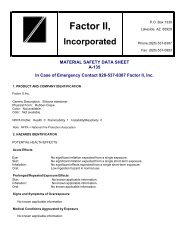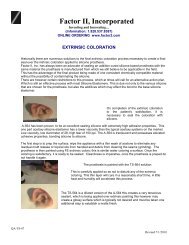You also want an ePaper? Increase the reach of your titles
YUMPU automatically turns print PDFs into web optimized ePapers that Google loves.
<strong>Factor</strong> <strong>II</strong>,<br />
<strong>Inc</strong>orporated<br />
P.O. Box 1339<br />
Lakeside, AZ 85929<br />
Phone:(928) 537-8387<br />
Fax: (928) 537-0893<br />
MATERIAL SAFETY DATA SHEET<br />
A-306<br />
Primer<br />
In Case of emergency contact CHEMTREC<br />
Within USA/Canada 1-800-424-9300<br />
Outside USA/Canada +1 703-527-3887<br />
<strong>Factor</strong> <strong>II</strong> Technology urges each customer or recipient of this <strong>MSDS</strong> to study it carefully to become aware of and<br />
understand the hazards associated with the product. The reader should consider consulting reference works or<br />
individuals who are experts in ventilation, toxicology, and fire prevention, as necessary or appropriate to the use and<br />
understanding of the data contained in this <strong>MSDS</strong>.<br />
To promote safe handling each customer or recipient should: (1) notify and furnish its employees, agents, contractors,<br />
customers, and others whom it knows or believes will use this material of the information regarding hazards or safety; (2)<br />
request its customers to notify their employees, customers and other users of the product of this information.<br />
1. CHEMICAL PRODUCT<br />
PRODUCT NAME: A-306<br />
CHEMICAL NAME: N/A<br />
CHEMICAL FAMILY: Silicone Primer<br />
FORMULA: Proprietary<br />
MOLECULAR WEIGHT: N/A<br />
SYNONYMS: N/A<br />
CAS#: Mixture<br />
2. HAZARDOUS INGREDIENTS<br />
%<br />
85<br />
5<br />
5<br />
5<br />
MATERIAL<br />
Napththa, VM&P<br />
Tetra-n-propyl silicate<br />
Tetrabutyltitanate***<br />
Tetra (2-methoxyethoxy)<br />
silane<br />
CAS#<br />
08030-30-6<br />
00682-01-9<br />
05593-70-4<br />
02157-45-1<br />
EXPOSURE VALUE<br />
See Section 8<br />
See Section 8<br />
See Section 8<br />
See Section 8<br />
CLASSIFICATION<br />
See Section 7<br />
See Section 7<br />
See Section 7<br />
See Section 7<br />
3. HAZARDS IDENTIFICATION<br />
EFFECTS OF SINGLE OVEREXPOSURE:<br />
SWALLOWING:<br />
Slightly toxic. May cause nausea, abdominal discomfort, vomiting, and diarrhea. Swallowing large quantities may lead to<br />
central nervous system disturbances, such as convulsions, depression, or coma. Aspiration into the lungs may occur<br />
during ingestion or vomiting, resulting in lung injury.<br />
SKIN ABSORPTION:<br />
QA-<strong>MSDS</strong>-07<br />
Revised 1/31/2013
<strong>Factor</strong> <strong>II</strong>,<br />
<strong>Inc</strong>orporated<br />
P.O. Box 1339<br />
Lakeside, AZ 85929<br />
Phone:(928) 537-8387<br />
Fax: (928) 537-0893<br />
No evidence of adverse effects from available information.<br />
INHALATION:<br />
Causes irritation of the respiratory tract, experienced as nasal discomfort and discharge with chest pain and coughing.<br />
Dizziness and drowsiness may occur. Eye irritation may occur. Severed overexposure by inhalation may result in<br />
permanent lung damage.<br />
SKIN CONTACT:<br />
Brief contact not irritating. Prolonged contact, as from wet clothing from material, may cause moderate irritation with<br />
redness and slight burn.<br />
EYE CONTACT:<br />
Liquid and Vapor may cause irritation, experienced as stinging with excess blinking and tear production. Redness and<br />
swelling of the conjunctiva may occur. High vapor concentration may cause same symptoms.<br />
EFFECTS OF REPEATED OVEREXPOSURE:<br />
Inhalation over a prolonged period will produce symptoms of dizziness, weakness, pain in the limbs, paresthesias,<br />
nervousness, and lead to anemia and weight loss.<br />
Repeated overexposure to Tetra (2-meethoxyethoxy) silane may cause injury to bone marrow, blood cells, and testes.<br />
MEDICAL CONDITIONS AGGRAVATED BY OVEREXPOSURE:<br />
Because of its irritating and defatting properties, this material may aggravate and existing dermatitis.<br />
SIGNIFICANT LABORATORY DATA WITH POSSIBLE RELEVANCE TO HUMAN HEALTH HAZAPD EVA LUATION:<br />
Prolonged and repeated inhalation exposure to hydrocarbon vapor in the same boiling range has produced kidney<br />
damage in male rats. This effect has not been observed in female rats and male and female mice. The relevance of this<br />
information to humans is unknown.<br />
The EPA has expressed concern regarding the possible adverse health effects resulting from the inhalation of<br />
alkoxysilanes and has recommended that administrative and mechanical means be used to minimize exposure.<br />
n-Propanol (which is generated upon exposure to water and or mosture has been demonstrated to be carcinogenic in<br />
lifetime expsure studies in rats when administered orally or subcutaneously.<br />
OTHER EFFECTS OF OVEREXPOSURE<br />
None currently known.<br />
4. FIRST AID MEASURES<br />
EMERGENCY AND FIRST AID PROCEDURES:<br />
SWALLOWING:<br />
Do not induce vomiting. Do not give anything to drink. Obtain medical attention without delay.<br />
SKIN:<br />
Wash with soap and water.<br />
INHALATION:<br />
Remove to fresh air. Give artificial respiration if not breathing. Qualified personnel may give oxygen if breathing is<br />
difficult.<br />
Obtain Medical attention.<br />
QA-<strong>MSDS</strong>-07<br />
Revised 1/31/2013
<strong>Factor</strong> <strong>II</strong>,<br />
<strong>Inc</strong>orporated<br />
P.O. Box 1339<br />
Lakeside, AZ 85929<br />
Phone:(928) 537-8387<br />
Fax: (928) 537-0893<br />
EYES:<br />
Immediately flush eyes with water and continue washing for at least 15 minutes. Obtain medical attention.<br />
NOTES TO PHYSICIAN:<br />
Laboratory findings in poisoning may include reduction of red cell count, possible bone marrow hypoplasia, albuminuria,<br />
and red cells in urine. If only a small amount of this product has been ingested and if there is likely to be a significant<br />
delay before emergency medical help is available, then in the absence of signs and symptoms of CNS depression or<br />
convulsions, and when the gag reflex is intact, ipecac may be used to produce vomiting. If vomiting is induced, the<br />
patient’s head and upper body must be kept at a lower level than the hips to assist in the prevention of aspiration.<br />
Aspirated material may cause severe lung damage and present a significant hazard.<br />
If a significant amount of product is ingested, remove by means of gastric lavage using activated charcoal. A cuffed<br />
endotracheal tube should be used to prevent aspiration. When evacuation of the stomach is complete, 30-60ml of Fleet’s<br />
Phospho-Soda diluted 1:4 in water may be given. Keep the patient under observation for 24 hours and check for signs of<br />
lung injury. It may require 2-4 weeks for resolution of lung infiltrates involving more than 30% of the lung volume.<br />
5. FIRE FIGHTING MEASURES<br />
FLASH POINT (test method(s): 63 º F (Tag Closed Cup)<br />
FLAMMABLE LIMITS IN AIR (by volume):<br />
LOWER: 1% UPPER: 6%<br />
EXTINGUISHING MEDIA:<br />
Apply alcohol-type or universal-type foams by manufacturers' recommended techniques for large fires. Use carbon<br />
dioxide, or dry chemical media for small fires.<br />
SPECIAL FIRE FIGHTING PROCEDURES:<br />
Do not direct a solid stream of water or foam directly into a pool of hot, burning liquid as this may cause frothing, and may<br />
intensify the fire. Use self-contained breathing apparatus when fighting fire in an enclosed area.<br />
UNUSUAL FIRE AND EXPLOSION HAZARDS:<br />
Vapors form from this product and may travel or be moved by air currents and ignited by pilot lights, other flames,<br />
smoking, sparks, heaters, electrical equipment, static discharges or other ignition sources at locations distant from<br />
product handling point.<br />
Vapors from this product may settle in low or confined areas, or travel a long distance to an ignition source and flash back<br />
explosively.<br />
Flammable liquid. Static sparks may ignite vapor. Use proper bonding and grounding during liquid transfer as described<br />
in National Fire Protection Association document NFPA 77.<br />
Do not extinguish fires with water. Contact with water may generate n-Propanol, n-Butanol or 2-Methoxyethanol which<br />
are highly flammable.<br />
6. ACCIDENTAL RELEASE MEASURES<br />
STEPS TO BE TAKEN IF MATERIAL IS RELEASED OR SPILLED:<br />
Extinguish and do not turn on any ignition source until the area is determined to be free from explosion or fire hazards.<br />
See Section 5.<br />
Spills should be contained. Large spills removed by vacuum. Smaller spills may be soaked up with absorbent.<br />
QA-<strong>MSDS</strong>-07<br />
Revised 1/31/2013
<strong>Factor</strong> <strong>II</strong>,<br />
<strong>Inc</strong>orporated<br />
P.O. Box 1339<br />
Lakeside, AZ 85929<br />
Phone:(928) 537-8387<br />
Fax: (928) 537-0893<br />
WASTE DISPOSAL METHOD: Dispose of in accordance with all Federal, State, and local regulations.<br />
7. HANDLING AND STORAGE<br />
PRECAUTIONS TO BE TAKEN IN HANDLING AND STORAGE:<br />
Normal precautions common to safe manufacturing practice should be followed in handling and storage.<br />
Keep container closed, in a cool dry place<br />
Keep away from heat and sources of ignition<br />
Avoid contact with skin and eyes<br />
In case of fire do not breathe fumes<br />
Highly Flammable<br />
Harmful if inhaled, contacts skin or swallowed<br />
Health resk from prolonged exposure<br />
S3/S7/S8<br />
S15/S16<br />
S24/S25<br />
S41<br />
Rl0<br />
R36/R37<br />
R40<br />
Contains Tetra (2-methoxyethoxy) silane—In laboratory animal studies, birth defects and adverse effects on preganacy<br />
have been observed.<br />
Contact with water or moisture can generate potentially explosive concentrations of n-Butanol, n-Propanol and 2-<br />
Methoxyethanol.<br />
WARNING: Hot organic chemical vapors or mists are susceptible to sudden spontaneous combustion when mixed with<br />
air. Ignition may occur at temperatures below those published in the literature as 'autoignition" or 'ignition" temperatures.<br />
Ignition temperatures decrease with increasing vapor volume and vapor/I air contact time, and are influenced by pressure<br />
changes.<br />
Ignition may occur at typical elevated-temperature process conditions, especially in processes operating under vacuum if<br />
subjected to sudden ingress of air, or outside process equipment operating under elevated pressure if sudden escape of<br />
vapors or mists to the atmosphere occurs.<br />
Any proposed use of this product in elevated-temperature processes should be thoroughly evaluated to assure that safe<br />
operating conditions are established and maintained.<br />
8. EXPOSURE CONTROLS / PERSONAL PROTECTION<br />
OCCUPATIONAL EXPOSURE VALUES AND SOURCE:<br />
Naphtha, VM&P: 100 ppm- 8 hours TWA (NIOSH, OSHA)<br />
400 ppm – 8 hours TWA (ACGIH)<br />
Tetra-n-propyl silicate: observe values for n-Propyl Alcohol, formed on exposure to water or humid air;<br />
200 PPM 8 HOURS TWA (SKIN) (ACGIH,OSHA, NIOSH)<br />
250 PPM 8 HOURS TWA (SKIN) (ACGIH,OSHA, NIOSH)<br />
Tetrabutyltitanate: observe values for n_butyl alcohol< formd on exposure to water or humid air:<br />
50 ppm – STEL/CEIL C (skin) (ACGIH, NIOSH)<br />
Tetra (2-methoxyethoxy) silane: observe values for 2-Methoxyethanol, formed on exposure to water or humid air<br />
5 ppm 8 hours TWA (skin) ACGIH<br />
25 ppm 8 hours TWA (skin) OSHA<br />
0.1 ppm 8 hours TWA (skin) NIOSH<br />
RESPIRATORY PROTECTION:<br />
QA-<strong>MSDS</strong>-07<br />
Revised 1/31/2013
<strong>Factor</strong> <strong>II</strong>,<br />
<strong>Inc</strong>orporated<br />
P.O. Box 1339<br />
Lakeside, AZ 85929<br />
Phone:(928) 537-8387<br />
Fax: (928) 537-0893<br />
Use NIOSH approved respirator or self-contained breathing apparatus as needed to maintain personal exposure below<br />
established Occupational Exposure Values.<br />
VENTILATION: General (mechanical) room ventilation with local ventilation as needed to maintain exposure below<br />
established Occupational Exposure Values.<br />
PROTECTIVE GLOVFS: Use solvent resistant gloves.<br />
EYE PROTECTION: Use safety goggles.<br />
0THER PROTECTIVE EQUIPMENT: Eye bath and safety shower.<br />
9. PHYSICAL AND CHEMICAL PROPERTIES (based on typical material)<br />
BOILING POINT: @ 760 mm Hg ~210ºF / 99ºC<br />
SPECIFIC GRAVITY (H 2 0=1): 0.76<br />
FREEZING POINT: N/A<br />
VAPOR PRESSURE, 25 mm Hg @ 77º F - 25ºC:<br />
VAPOR DENSITY (air=l): ~3.8<br />
EVAPORATION RATE (Butyl Acetate=l): Not Determined<br />
SOLUBILITY IN WATER (By wt): Not Determined<br />
APPEARANCE: Clear to Amber<br />
ODOR: Solvent<br />
PHYSICAL STATE: Liquid<br />
PERCENT VOLATILES (by wt): See Section 15<br />
Note: The above information is not intended for use in preparing product specifications.<br />
10. STABILITY AND REACTIVITY DATA<br />
STABILITY: Stable.<br />
CONDITIONS TO AVOID: Avoid open flame and other ignition sources avoid water, moisture, and humidity.<br />
INCOMPATIBILITY: Strong Oxidizing materials moisture or humid air.<br />
HAZARDOUS COMBUSTION OR DECOMPOSITION PRODUCTS:<br />
Burning can produce carbon monoxide, carbon dioxide, oxides of silicon, and hydrocarbons. Carbon monoxide is highly<br />
toxic if inhaled; carbon dioxide in sufficient concentrations can act as an asphyxiant. Acute overexposure to the products<br />
of combustion may result in irritation of the respiratory tract.<br />
HAZARDOUS POLYMERIZATION: Will not occur.<br />
11. TOXICOLOGICAL INFORMATION<br />
COMPONENT:<br />
Acute Oral LD 50 (mg/kg):<br />
Acute Dermal LD 50 (mg/kg):<br />
Acute Inhalation LC 50 (mg/l):<br />
Other:<br />
50-500 (Rat) Inferred from ingredient hazard(s)<br />
200-1000 (Rbt.) Inferred from ingredient hazard(s)<br />
0.5-2 (Rat) Inferred from ingredient hazard(s)<br />
N/A.<br />
QA-<strong>MSDS</strong>-07<br />
Revised 1/31/2013
<strong>Factor</strong> <strong>II</strong>,<br />
<strong>Inc</strong>orporated<br />
P.O. Box 1339<br />
Lakeside, AZ 85929<br />
Phone:(928) 537-8387<br />
Fax: (928) 537-0893<br />
Ames Test:<br />
N/A.<br />
Refer to Section 3 for further discussion of the health hazards associated with this preparation.<br />
12. ECOLOGICAL INEORMATION<br />
ECOTOXICOLOGICAL INFORMATION:<br />
CHEMICAL FATE INFORMATION:<br />
Complete information not yet available.<br />
Complete information not yet available.<br />
13. DISPOSAL CONSIDERATIONS<br />
Dispose of in accordance with all Federal, State, and local regulations.<br />
14. TRANSPORT INFORMATION<br />
I.A.T.A. and D.O.T. HAZARD CLASSIFICATION:<br />
Proper Shipping Name: Petroleum Distillates, n.o.s. (Naphtha Solution 85%)<br />
Hazard Class: 3<br />
Hazard Label: Flammable liquid<br />
UN Number: UN 1268<br />
UN Packing Group: <strong>II</strong><br />
15. REGULATORY INFORMATION<br />
STATUS ON SUBSTANCE LISTS:<br />
The concentrations shown are maximum or ceiling levels (weight %) to be used for calculations for regulations.<br />
Trade Secrets are indicated by "TS".<br />
C H I P REGULATIONS<br />
Chemicals (Hazards Information and Packaging) Regulations 1993 requires physico-chemical and health hazard<br />
determination of all substances and preparations manufactured, transported, stored, modified, or consumed within the<br />
EEC. Components present in this product at a level which could require reporting under the statute are:<br />
Material<br />
Naptha, VM&P<br />
*n-Butyl Alcohol<br />
*2-Methoxyethanol<br />
n-Propyl Alcohol<br />
FEDERAL EPA<br />
CAS NUMBER<br />
08030-30-6<br />
00071-36-3<br />
00109-86-4<br />
00071-23-8<br />
Trace amounts may be formed on exposure to moisture or humid air.<br />
UPPER BOUND<br />
CONCENTRATION<br />
85%<br />
Trace Amount<br />
Trace Amount<br />
Trace Amount<br />
Comprehensive Environmental Response Compensation and Liability Act of 1980 (CERCLA) requires notification of the<br />
National Response Center of release of quantities of Hazardous Substances equal to or greater than the reportable<br />
quantities (RQ's) in 40 CFR 302.4. Components present in this product at a level which could require reporting under the<br />
statute are:<br />
Material CAS NUMBER UPPER BOUND<br />
QA-<strong>MSDS</strong>-07<br />
Revised 1/31/2013
<strong>Factor</strong> <strong>II</strong>,<br />
<strong>Inc</strong>orporated<br />
P.O. Box 1339<br />
Lakeside, AZ 85929<br />
Phone:(928) 537-8387<br />
Fax: (928) 537-0893<br />
*n-Butyl Alcohol 00071-36-3 CONCENTRATION<br />
Trace Amount<br />
*(Trace amounts may be formed on exposure to moisture or humid air.)<br />
Superfund Amendments and Reauthorization Act of 1986 (SARA) Title <strong>II</strong>I requires emergency planning based on<br />
Threshold Planning Quantities (TPQ's) and release reporting based on Reportable Quantities (RQ's) in 40 CFR 355<br />
(used for SARA 302, 304, 3~ 1, and 312). Components present in this product at a level which could require reporting<br />
under the statute are: **** NONE ****<br />
Superfund Amendments and Reauthorization Act of 1986 (SARA) Title <strong>II</strong>I requires submission of annual reports of<br />
release of toxic chemicals that appear in 40 CFR 372 (for SARA 3 ~ 3). This information must be included in all MSD S's<br />
that are copied and distributed for this material. Components present in this product at a level which could require<br />
reporting under this statute are:<br />
Material<br />
*n-Butyl Alcohol<br />
*2-Methoxyethanoll<br />
CAS NUMBER<br />
00109-86-4<br />
00067-56-1<br />
*(Trace amounts may be formed on exposure to moisture or humid air.)<br />
UPPER BOUND ONCENTRATION<br />
Trace Amount<br />
Trace Amount<br />
INVENTORY STATUS<br />
The ingredients of this product are listed on, or are exempt from listing on, the TSCA inventory.<br />
STATE-RIGHT-TO-KNOW<br />
CALIFORNIA Proposition 65<br />
This product contains no levels of listed substances, which the State of California has found to cause cancer, birth<br />
defects or other reproductive harm, which would require a warning under the statute.<br />
2-Methoxyethanol (Ethylene glycol monomethyl ethr_<br />
Trace amounts may be give off during hydrolyzation<br />
MASSACHUSETTS 105 CMR 670.000 Right-To-Know, Substance List (MSL)<br />
Hazardous Substances and Extraordinarily Hazardous Substances on the MSL must be identified when present in<br />
products. Components present in this product at a level which could require reporting under the statute are:<br />
Material<br />
Naptha, VM&P<br />
*n-Butyl Alcohol<br />
*2-Methoxyethanol<br />
n-Propyl Alcohol<br />
CAS NUMBER<br />
08030-30-6<br />
00071-36-3<br />
00109-86-4<br />
00071-23-8<br />
Trace amounts may be formed on exposure to moisture or humid air.<br />
UPPER BOUND<br />
CONCENTRATION<br />
85%<br />
Trace Amount<br />
Trace Amount<br />
Trace Amount<br />
PENNSYLVANIA Right-To-Know, Hazardous Substance List<br />
Hazardous Substances and Special Hazardous Substances on the List must be identified when present in products.<br />
Components present in this product at a level which could require reporting under the statute are:<br />
Material<br />
Naptha, VM&P<br />
*n-Butyl Alcohol<br />
*2-Methoxyethanol<br />
n-Propyl Alcohol<br />
CAS NUMBER<br />
08030-30-6<br />
00071-36-3<br />
00109-86-4<br />
00071-23-8<br />
Trace amounts may be formed on exposure to moisture or humid air.<br />
UPPER BOUND<br />
CONCENTRATION<br />
85%<br />
Trace Amount<br />
Trace Amount<br />
Trace Amount<br />
QA-<strong>MSDS</strong>-07<br />
Revised 1/31/2013
<strong>Factor</strong> <strong>II</strong>,<br />
<strong>Inc</strong>orporated<br />
P.O. Box 1339<br />
Lakeside, AZ 85929<br />
Phone:(928) 537-8387<br />
Fax: (928) 537-0893<br />
CALIFORNIA SCAQMD RULE 443.1 VOC'S:<br />
Volatile Organic Components (VOC's) = Substances with vapor pressure of > 0.5 mm Hg at 140ºC (219.2ºF).<br />
This product contains < 635g/liter VOC’s.<br />
OTHER REGULATORY INFORMATION:<br />
EPA Hazard Categories: Fire Hazard<br />
Immediate Health Hazard<br />
Delayed Health Hazard<br />
C.H.I.P. Regulations:<br />
Designation: A-306<br />
Symbol:<br />
Flammable and Harmful<br />
Indication of Danger: Flammable and Harmful<br />
Safety Phrases: S3/S7/S8/S15/S16/S24/S25/S41<br />
(Ref. Sect. 7) R10/R36/R37<br />
16. OTHER INFORMATION<br />
HMIS FORMAT:<br />
Health: 2 Flammability: 3 Reactivity: 0<br />
We believe that the information contained herein is current as of the date of this Material Safety Data Sheet, and is<br />
offered in good faith. Since the use of this information and of these opinions and the conditions of the use of the product<br />
are not within the control of <strong>Factor</strong> <strong>II</strong> Technology, it is the user's obligation to determine the conditions of safe use of the<br />
product.<br />
<strong>Factor</strong> <strong>II</strong> Technology Regulatory Compliance Department<br />
QA-<strong>MSDS</strong>-07<br />
Revised 1/31/2013


